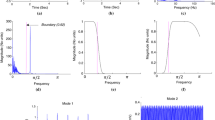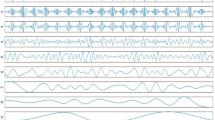Abstract
This paper presents an efficient methodology based on empirical wavelet transform (EWT) to remove cross-terms from the Wigner–Ville distribution (WVD). An EWT-based filter bank method is suggested to remove the cross-terms that occur due to nonlinearity in modulation. The mean-square error-based filter bank bandwidth selection is done which has been applied for the boundaries selection in EWT. In this way, a signal-dependent adaptive boundary selection is performed. Thereafter, energy-based segmentation is applied in time domain to eliminate inter-cross-terms generated between components. Moreover, the WVD of all the components is added together to produce a complete cross-terms-free time–frequency distribution. The proposed method is compared with other existing methods, and normalized Rényi entropy measure is also computed for validating the performance.










Similar content being viewed by others
References
Andria, G., Savino, M.: Interpolated smoothed pseudo Wigner–Ville distribution for accurate spectrum analysis. IEEE Trans. Instrum. Meas. 45, 818–823 (1996)
Boashash, B.: Time–Frequency Signal Analysis and Processing: A Comprehensive Reference. Elsevier, Amsterdam (2003)
Baydar, N., Ball, A.: A comparative study of acoustic and vibration signals in detection of gear failures using Wigner–Ville distribution. Mech. Syst. Signal Process. 15, 1091–1107 (2001)
Bhattacharyya, A., Pachori, R.B.: A multivariate approach for patient-specific EEG seizure detection using empirical wavelet transform. IEEE Trans. Biomed. Eng. 64, 2003–2015 (2017)
Bhattacharyya, A., Singh, L., Pachori, R.B.: Fourier–Bessel series expansion based empirical wavelet transform for analysis of non-stationary signals. Digit. Signal Process. 78, 185–196 (2018)
Chen, J., Pan, J., Li, Z., Zi, Y., Chen, X.: Generator bearing fault diagnosis for wind turbine via empirical wavelet transform using measured vibration signals. Renew. Energy 89, 80–92 (2016)
Chen, V.C., Ling, H.: Time–Frequency Transforms for Radar Imaging and Signal Analysis. Artech House, Norwood (2002)
Choi, H.I., Williams, W.J.: Improved time–frequency representation of multicomponent signals using exponential kernels. IEEE Trans. Acoust. Speech Signal Process. 37, 862–871 (1989)
Claasen, T.A.C.M., Mecklenbrauker, W.F.G.: The Wigner distribution—a tool for time–frequency signal analysis. Part I: continuous-time signals. Philips J. Res 35(3), 217–250 (1980)
Climente-Alarcon, V., Antonino-Daviu, J.A., Riera-Guasp, M., Vlcek, M.: Induction motor diagnosis by advanced notch FIR filters and the Wigner–Ville distribution. IEEE Trans. Ind. Electron. 61, 4217–4227 (2014)
Daubechies, I.: Ten Lectures on Wavelets, vol. 61. SIAM, Philadelphia (1992)
Dragomiretskiy, K., Zosso, D.: Variational mode decomposition. IEEE Trans. Signal Process. 62, 531–544 (2014)
Flandrin, P., Escudié, B.: An interpretation of the pseudo-Wigner–Ville distribution. Signal Process. 6, 27–36 (1984)
Gaikwad, C.J., Sircar, P.: Reduced interference Wigner–Ville time frequency representations using signal support information. In: 2016 IEEE Annual India Conference, pp. 1–5. IEEE (2016)
Gaikwad, C.J., Sircar, P.: Bispectrum-based technique to remove cross-terms in quadratic systems and Wigner–Ville distribution. Signal Image Video Process. 12(4), 703–710 (2018)
Gavrovska, A., Bogdanović, V., Reljin, I., Reljin, B.: Automatic heart sound detection in pediatric patients without electrocardiogram reference via pseudo-affine Wigner–Ville distribution and Haar wavelet lifting. Comput. Methods Programs Biomed. 113, 515–528 (2014)
Gilles, J.: Empirical wavelet transform. IEEE Trans. Signal Process. 61, 3999–4010 (2013)
Hu, X., Peng, S., Hwang, W.L.: EMD revisited: a new understanding of the envelope and resolving the mode-mixing problem in AM–FM signals. IEEE Trans. Signal Process. 60, 1075–1086 (2012)
Huang, N.E., Shen, Z., Long, S.R., Wu, M.C., Shih, H.H., Zheng, Q., Yen, N.C., Tung, C.C., Liu, H.H.: The empirical mode decomposition and the Hilbert spectrum for nonlinear and non-stationary time series analysis. In: Proceedings of the Royal Society of London A: Mathematical, Physical and Engineering Sciences, vol. 454, pp. 903–995. The Royal Society (1998)
Jain, P., Pachori, R.B.: Time-order representation based method for epoch detection from speech signals. J. Intell. Syst. 21, 79–95 (2012)
Jain, P., Pachori, R.B.: Marginal energy density over the low frequency range as a feature for voiced/non-voiced detection in noisy speech signals. J. Frankl. Inst. 350, 698–716 (2013)
Kadambe, S., Boudreaux-Bartels, G.F.: A comparison of the existence of ‘cross terms’ in the Wigner distribution and the squared magnitude of the wavelet transform and the short-time Fourier transform. IEEE Trans. Signal Process. 40, 2498–2517 (1992)
Kazemi, K., Amirian, M., Dehghani, M.J.: The S-transform using a new window to improve frequency and time resolutions. Signal Image Video Process. 8(3), 533–541 (2014)
Stankovic, L., Daković, M., Thayaparan, T.: Time–Frequency Signal Analysis with Applications. Artech House, Norwood (2013)
Liu, W., Cao, S., Chen, Y.: Seismic time–frequency analysis via empirical wavelet transform. IEEE Geosci. Remote Sens. Lett. 13, 28–32 (2016)
Meyer, Y.: Wavelets and Operators, vol. 1. Cambridge University Press, Cambridge (1992)
Pachori, R.B., Nishad, A.: Cross-terms reduction in the Wigner–Ville distribution using tunable-Q wavelet transform. Signal Process. 120, 288–304 (2016)
Pachori, R.B., Sircar, P.: A new technique to reduce cross terms in the Wigner distribution. Digit. Signal Process. 17, 466–474 (2007)
Pachori, R.B., Sircar, P.: Time–frequency analysis using time-order representation and Wigner distribution. In: 2008 IEEE Region 10 Conference, pp. 1–6 (2008)
Ping, D., Zhao, P., Deng, B.: Cross-terms suppression in Wigner–Ville distribution based on image processing. In: 2010 IEEE International Conference on Information and Automation, pp. 2168–2171. IEEE (2010)
Ren, H., Ren, A., Li, Z.: A new strategy for the suppression of cross-terms in pseudo Wigner–Ville distribution. Signal Image Video Process. 10, 139–144 (2016)
Sharma, R.R., Pachori, R.B.: A new method for non-stationary signal analysis using eigenvalue decomposition of the Hankel matrix and Hilbert transform. In: Fourth International Conference on Signal Processing and Integrated Networks, pp. 484–488. IEEE (2017)
Sharma, R.R., Pachori, R.B.: Eigenvalue decomposition of Hankel matrix based time–frequency representation for complex signals. Circuits Syst. Signal Process. 37(8), 3313–3329 (2018)
Sharma, R.R., Pachori, R.B.: Improved eigenvalue decomposition based approach for reducing cross-terms in Wigner–Ville distribution. Circuits Syst. Signal Process. 37(8), 3330–3350 (2018)
Sharma, R.R., Pachori, R.B.: Time–frequency representation using IEVDHM–HT with application to classification of epileptic EEG signals. IET Sci. Meas. Technol. 12, 72–82 (2018)
Stanković, L.: A measure of some time–frequency distributions concentration. Signal Process. 81, 621–631 (2001)
Upadhyay, A., Pachori, R.B.: Instantaneous voiced/non-voiced detection in speech signals based on variational mode decomposition. J. Frankl. Inst. 352, 2679–2707 (2015)
Wang, Z., Bovik, A.C.: Mean squared error: love it or leave it? A new look at signal fidelity measures. IEEE Signal Process. Mag. 26(1), 98–117 (2009)
Wu, Y., Li, X.: Elimination of cross-terms in the Wigner–Ville distribution of multi-component LFM signals. IET Signal Process. 11(6), 657–662 (2017)
Author information
Authors and Affiliations
Corresponding author
Additional information
Publisher's Note
Springer Nature remains neutral with regard to jurisdictional claims in published maps and institutional affiliations.
Rights and permissions
About this article
Cite this article
Sharma, R.R., Kalyani, A. & Pachori, R.B. An empirical wavelet transform-based approach for cross-terms-free Wigner–Ville distribution. SIViP 14, 249–256 (2020). https://doi.org/10.1007/s11760-019-01549-7
Received:
Revised:
Accepted:
Published:
Issue Date:
DOI: https://doi.org/10.1007/s11760-019-01549-7




